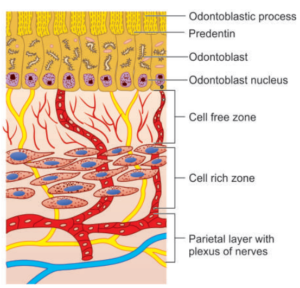Once I had a severe tooth ache and the dentist said to me” Your pulp got exposed”, It was the first time I heard the term PULP. I did not know what it was. Later on, I went back and searched What is Dental Pulp? and came to learn more about the same. In Endodontics majority of the chapters are about Dental Pulp.
So I thought to write a blog about Dental Pulp so that it would be useful for you also.
What is a Dental Pulp?
The dental pulp is the tooth’s innermost layer, which contains blood vessels, nerves, and connective tissues. The function of the dental pulp is to create dentin and provide nutrition such as albumin, globulin, and moisture to the tooth. Blood vessels help to keep the pulp moistened and prevent it from becoming brittle.
Contents
What are the zones of pulp?
We know that pulp is the connective tissue that resides within the tooth structure. There are various zones of pulp:
- ODONTOBLASTIC LAYER AT THE PERIPHERY.
- CELL-FREE ZONE OF WEIL.
- CELL RICH ZONE.
- PULP CORE.
Odontoblastic Layer:
- The odontoblastic layer is found in the periphery.
- It contains cell bodies and cytoplasmic processes
- The odontoblastic layer contains the odontoblastic cell bodies that form the odontoblastic zones where the odontoblastic process is located at the present matrix
- It contains capillaries, nerve fibers, and dendritic cells.
Cell-Free Zone of Weil:
- It is located in the center of the odontoblast.
- It is also called as Subodontoblastic layer.
- It contains a plexus of capillaries and nerve fiber ramification
- It is not present in developing teeth but prominent in coronal pulp after development.
Cell Rich Zone:
- From the term its, we can say it’s very rich 🙂 that means it contains fibroblasts, undifferentiated cells, macrophages, and capillaries.
- Capillaries form an extensive vascular system.
Pulp Core:
- It is the central zone.
- It acts as a support system for peripheral blood vessels and nerves.
- Principle cells are fibroblasts with collagen as a ground substance.
What are the Contents of Pulp?Cells:
Matrix:
Blood vessels:
Lymphatics:
Nerves:
|
Conclusion
Pulp is divided into two types: coronal pulp and radicular pulp. The pulp which is present in the coronal part is called the coronal pulp and the pulp which is present in the radicular part is called the radicular pulp. The cells of the pulp differ from person to person. The pulp helps in preserving the vitality of the tooth. It also helps in defense mechanisms and protection.
I had tried my best to include all the details about Zones of Pulp. If you are having any questions, feel free to comment your queries below and I will try my best to revert back as soon as possible.
One Small Request!
If you feel this article is worth reading, please do share it with your friends and students in need.


